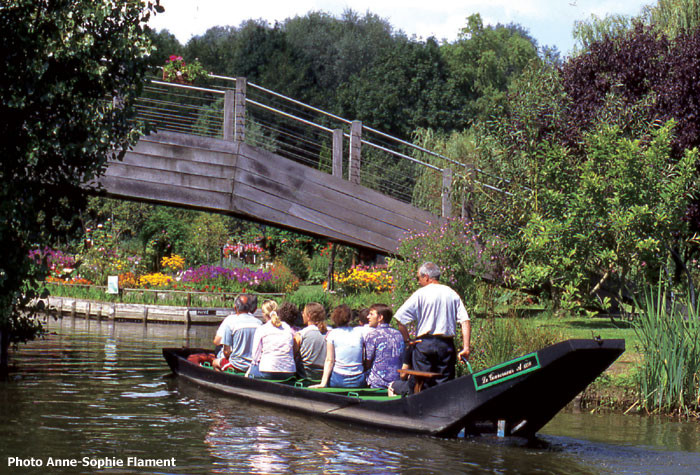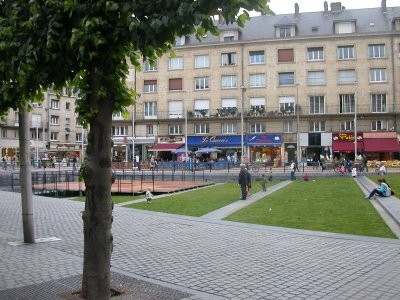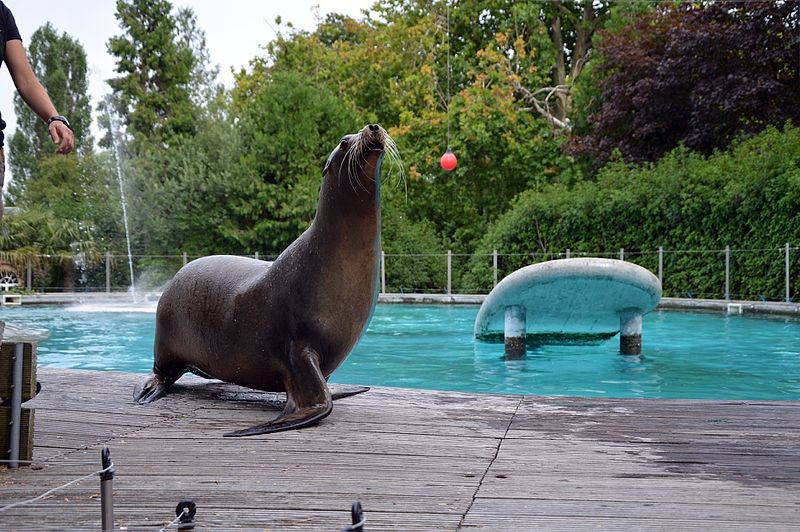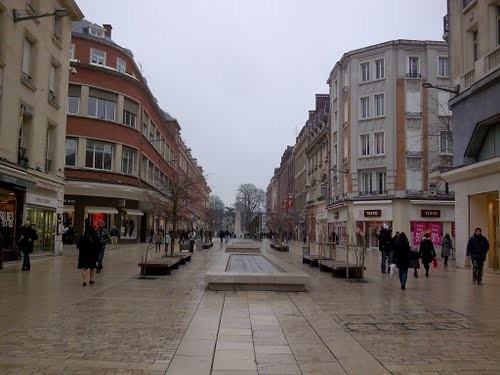What to see in Amiens
1. The Cathedral Basilica of Our Lady of Amiens (Amiens Cathedral):

Of course, the cathedral is what is highlighted the most in this city and is one of the things you must see first. Its name in English is Our Lady and it's a church, considered to be the city's cathedral, where the religion of Catholicism is practised.
It's a Gothic cathedral; in fact, it's the last classical style Gothic cathedral. They began constructing it in 1220 on top of the ruins of another cathedral that was completely destroyed by a fire.
It was designed with a Latin cross-style floor, between 1366 and 1401, to which the towers that we can see today were later added to the sides of the main structure, which make the cathedral the wonder that it is. The central nave has a beautiful rosette over a base full of sculptures that decorate the whole part of the main doorway.
The main façade is formed of 3 big porticos. This whole façade represents, in different stages, some very representative parts of both the Old and New Testaments, which is why they call it the "Amiens Bible".
Having been built based on the styles of Paris' Notre-Dame and that of Chartres, Amiens Cathedral is the biggest and of the highest altitude of all the gothic cathedrals in France, reaching 142m in height. It was also declared as a World Heritage Site by UNESCO in 1862. In the cathedral square, we can take a horse-drawn carriage that gives sightseeing tours of the city. Personally, I have never taken one, so I cannot tell you what exactly the tour entails. Truthfully, I don't really like the idea of it; it's a carriage with just two horses and it's always fully loaded with people that they have to carry around.
2. Jules Verne House:
It was in this house that the famous writer, Jules Verne, lived 18 years of his life - between 1882 and 1900. Not long after his death, the house was reopened to the public, having become a true cult place and a centre of literary, cultural and scientific interpretation in memory of the author.
A famous draughtsman born in Belgium redesigned the house in which the writer had lived and had given life to 34 of his novels, and now we can enjoy the fruits of his labour, in addition to appreciate the setting of where it all came to life and where his famous characters were created.
We consider Jules Verne to be one of the creators of the science fiction genre, thanks to the huge vision he had for the era in which he lived. Before anybody else could see it as something feasible, he talked about journeys to the moon and below the sea. Better known as the first modern science fiction author, Jules Verne was a visionary of his time: he imagined a journey to the moon at the end of the 19th century and a world under the sea that we could live in.
3. The Dewailly clock:
Halfway between the cathedral and the Place Gambetta, we find ourselves by this clock, one of the symbolic structures of Amiens. Originally, it was located in the Place Gambetta, until it was destroyed during the war and the clock disappeared.
It was donated in 1896 by the then-mayor of the city, Dr. Dewailly, and was created by the architect, Émile Ricquier. The figure of the woman with her exposed chest is a work of Albert Roze, who, through this, wanted to make an allegory of spring.

4. Parc Saint Pierre:
Parc Saint Pierre is the most beautiful park in the city: it's a place where you can get in touch with nature, where you can exercise, run, play football, and even climb the giant trees...
Here, the majority of people go running or walk their dogs. Personally, I like to come here and feed the ducks and the swans. There's a really nice lake, full of ducks and breathtaking swans. Normally, I save some leftover bread every day, and when I have enough of it, I bring it here. It's nice to see all of the swans fly over with their huge wings and run towards the bread.
It's also an ideal place to have a picnic on the grass, as the park has a vast number of open green spaces, although it's best to do this in spring or in summer. Since I arrived here, it has rained quite a bit, and there are lots of puddles across the entire park. Even so, there are still some really beautiful days, when it's cold but the sun is shining. So, if you want to take advantage of one of those days, don't forget to bring something to sit down on so that your bum doesn't get wet, haha.

5. Hortillonnages d'Amiens:
In Picardy, the term "hortillonnage" is used to designate the swampy zones partially cut up by channels where the cultivation of crops takes place. The Hortillonnages of Amiens is a 300 hectare area of ancient marshland. Currently, horticultural activity is declining, leaving only around 25 hectares cultivated; the rest have been transformed into recreational areas and secondary residences, and into a land rich in several species of animals. In addition to this, the Hortillonnages are one of the most visited places in the city, thanks to tourism, with some 100, 000 visitors per year, as you can visit by boat from April 1st to October 31st.

6. Zoo d'Amiens:
Located on the Hotoie esplanade, the idea for Amiens Zoo was conceived in 1952. Previously a botanical garden, it was renovated in 1994 into a zoological park. It has more than 400 animals of 70 different species for tourists to enjoy all year round. The zoo's animals are in their natural environments, ones that are full of centennial trees and are surrounded by water.
The Amiens Metropole Municipal Park is involved in the conservation of endangered species. Naturally, being oriented towards animal welfare, it is part of the conservation network, including new European zoos, and is a permanent member of EAZA: the European Association of Zoos and Aquariums.

Information:
- From 1st April to 30th September: open Monday to Saturday, 10am to 6pm, and Sundays and public holidays, 10am to 7pm.
- October, November, February and March: open Wednesday, Saturday, Sunday and on public holidays, 2pm to 5pm.
- December and January: open Sunday, 2pm to 5pm.
For adults, in peak season, entry costs 5. 50€, and off-peak, 3. 50€, although upon presentation of a valid student ID card, we benefit from a discounted rate (like everywhere here). I went last month during the off-peak season and I think I only paid 2€. I honestly think it's worth going to. The zoo is not particularly big, but there are lots of different monkeys; some of them shout and sound like ambulance sirens... it's very funny. On the zoo's website, you can see all of the animals that they have there and organise your visit.
7. Place Gambetta:
Place Gambetta is situated in the pedestrianised area of the city, in the heart of Rue de Trois Coilleux, Amien's famous shopping street. This square, surrounded by restaurants, cafes and shops attracts both tourists and locals alike, turning it into a common meeting point. Its fountain and stairs with the lawns make it a great place to sunbathe and cool down a bit during the summer months.

8. Le Palais de Justice:
This is a typical nineteenth century French construction, built in 1866 to be exact. It's made up of two lateral wings and a frontal wing that connects them both. Natalis Daullé and John Herbault were the architects tasked with its construction. The sculptors were Edmon Lévéque and Samson.
The front part is accessed by a beautiful staircase up to the portico of the Corinthian hexastyle, with columns of the same style placed against it. The pediment represents order and justice; between the columns, we see the statues of Cicero and Demosthenes; and, to finish, those of the Law and the Force on the stairway.

9. Gare d'Amiens:
The Gare d'Amiens (previously the Gare du Nord) is the main station in the city. The station opened on 15th March 1847 to coincide with the opening of the Abbeville line.
The station building was later replaced by the current modern structure after the allied bombardment, and was built in 1955 by Auguste Perret. The famous tower called Tour Perret was built at the same time, close to the station. Besides being the train station, it is also where all the city's buses stop.

10. Rue de Trois Cailloux:
The main pedestrian thoroughfare in Amiens, known to all as the main shopping street, like all other cities have, which runs between the two mains squares in Amiens: the Place Gambetta and the Place René Goblet.
It's nice to go there both for a walk and to do some good shopping. Major international brands have found their place on this street, like Fnac, C&A, the famous French Galeries Lafayette, and, of course, McDonalds (how could there not be one? ). We can also find some of the best patisseries in the city here, with the famous macaroons, and don't forget to look at the trees all linked together along the entire length of the street.
11. The House of Culture of Amiens:
'La Maison de la culture', or 'House of Culture' in English, is a centre of creation and cultural production, as indicated by its name, where we can find all kinds of productions: theatre, dance, music, circus performances, cinema screenings...
The MCA (Maison de la culture d'Amiens, in French) sends a leaflet to homes across the city with its schedule on a weekly basis, and we can also find this information on its website. As with all places in this city, students receive a discount upon presentation of a 'carte d'estudiant'. You can find all of the prices on the website too.
To underline how worthwhile a visit here is, I will tell you that, in January, a touring company is coming to perform Tchaikovsky's Swan Lake ballet - I'm looking forward to seeing it! To quash anyone's curiosity, I'll also tell you that the House of Culture is also a very common meeting point in the city, as everyone knows where it is and it has a large number of bus stops close-by.
12. The Musée de Picardie:
This museum was created in the nineteenth century, between 1855 and 1867, under the reign of Napoleon III, and the building in which it is located was built with the objective of housing and designing this museum. It is one of the first modern buildings of this type built in France and one of the most beautiful, just as much for the cultural richness of its collections as for the architectural coherence of its gardens and its façade. The building was born thanks to the activism of the Society of Antiques in Picardy, which was anxious to create a place to house objects collected over several decades in the city of Amiens.
The museum has different sections, among which the pieces of art are distributed. On the one hand, we have the Middle Ages section, and, on the other, that of Fine Arts and Archaeology. We can find works by Joan Miro, José de Ribera, Frans Hals, El Greco, Gustave Courbet, Pablo Picasso, amongst others. The most impressive collection is that of the Egyptian art, which has more than four hundred objects and artefacts, although, at this point in time, we can only see two hundred and fifty-seven.
Currently, the first floor of the museum is closed for renovation works. Art exhibitions are held in the Grand Hall on the ground floor of the museum. In the basement, we can find the Archaeology, Medieval and Fine Arts collections, all of which are open to the public.
13. The Musée de l'Hôtel de Berny:
Built in 1633, the former Treasurers' Hotel is a beautiful display of the Louis XIII style, with pink brick rigging and a stone frame. Its last owner, Gérard de Berny (1880-1957), did everything he could to decorate it before leaving it to the city.
To provide a better reception and presentation of its extended collection, the Musée de l'Hôtel de Berny is closed for renovations. This renovation project is expected to continue until this year, and it includes the renovation of the 17th century building, the former hotel of the French treasurers, and the installation of the artefacts from the museum collections.
14. Bailiwick House (Maison du Bailliage):
The only part of this building built in 1541 that remains is the façade. Mullioned windows, flamboyant gables and Renaissance medallions captivate the gazes of many.
15. The Belfry:
It consists of a square base (that dates back to the fifteenth century) and a bell tower (from the eighteenth century) that is topped off with a dome.
16. Logis du Roy and Maison du Sagittaire:
This was the King's residence in 1565, and is situated on the periphery of the cathedral. On its door, we can see the Virgin Rose. The residents of this city are very proud of their legacy. Next to the King's house, we find the Maison du Sagittaire, from the year 1593, whose name comes from the zodiac sign, Sagittarius, which we can see adorning the arches of the house.
17. Chés cabotants of Amiens:
A visit to the theatre will enable you to become more familiar with the local personalities, like Lafleur and his wife, Sandrine... but that does not excuse you from going to one of the shows performed at this miniature theatre where the puppets talk in an entertaining mix of Picard and French.
18. The Church of Saint-Leu:
This picturesque neighbourhood, with its little houses and their coloured façades, invites visitors to wander its streets. Closely linked to water, the old Amiens is crossed by numerous canals. Cafés, restaurants, and pubs offer nice terraces... Handicraft stalls, antique stores, and second-hand dealers also attract passers-by. The effervescence of mill workers and artists from the past today makes way for the hustle and bustle of a student-dominated area.
Don't forget to visit the Church of Saint-Leu, from the fifteenth century, which stands out for its flamboyant bell tower, which came later in that century.
19. The Church of Saint-Germain:
This fifteenth century church of flamboyant Gothic style has an inclined bell tower.
20. The old theatre:
Built in 1780, this theatre boasts a Louis XVI style façade and three huge windows framed by elegant low-reliefs. In accordance with the times, the actors have given up the place to bankers.

21. Baie de Somme (Bay of the Somme):
Within the Baie de Somme, located 45 minutes away from Amiens, the Parc du Marquenterre is a vast, protected space where numerous species of birds make their nests.
22. Cirque Jules-Verne:
Built by the architect, Émile Ricquier, just as Émile Hittorff designed the circus on the Champs-Élysées in Paris, this circus was inaugurated in June 1889 by an illustrious city council member: Jules Verne. For this reason, it is more commonly known as the Cirque de Jules Verne.
23. Cimetière de la Madeleine:
Fans of Jules Verne cannot miss visiting the Twenty Thousand Leagues Under the Sea author's tomb presided over by a moving statue of Albert Roze (1861-1952).

Photo gallery
Content available in other languages
- Español: Qué ver en Amiens
- Italiano: Luoghi da visitare ad Amiens
Want to have your own Erasmus blog?
If you are experiencing living abroad, you're an avid traveller or want to promote the city where you live... create your own blog and share your adventures!
I want to create my Erasmus blog! →

























Comments (0 comments)